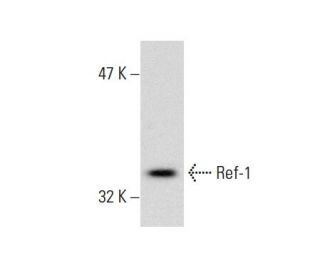


KNRK nuclear extract: sc-2141
- supplied in four vials, each containing 250 µg nuclear extract in 50 µl buffer
- provided in 20 mM HEPES (pH 7.9), 20% v/v glycerol, 0.1 M KCI, 0.2 mM EDTA, 0.5 mM PMSF and 0.5 mM DTT
- rat nuclear extract; K-Ras transformed kidney cells
- suitable for use in Gel Shift and Western Blotting assays
- Extracts should be stored at -70°C and repeated freezing and thawing should be avoided.
- prepared by the method of Dignam et al., (1983) Nucleic Acids Res. 11: 1475
QUICK LINKS
SEE ALSO...
KNRK nuclear extract is derived from the Kirsten rat sarcoma virus-transformed rat kidney epithelial cell line (KNRK), which serves as a potent resource for studying oncogenic signaling pathways. This nuclear extract contains a comprehensive profile of nuclear constituents, including transcription factors, regulatory proteins, and nucleic acids, pivotal for investigating gene regulation and cellular signaling mechanisms. KNRK nuclear extract is widely used in biochemical assays such as electrophoretic mobility shift assays (EMSA) to analyze DNA-binding activities of nuclear proteins, and chromatin immunoprecipitation (ChIP) to study the interactions between specific proteins and DNA sequences involved in oncogenic transformation. Research utilizing KNRK nuclear extract contributes significantly to understanding the nuclear signaling pathways activated by oncogenes like Ras, which are crucial for cellular proliferation and differentiation in kidney cells. This extract enables researchers to dissect the complex network of transcriptional regulators and their roles in cellular transformation processes, emphasizing its utility in fundamental research focused on cellular signaling and regulation. The origin and consistency of the KNRK cell line are rigorously verified to ensure reliability and relevance in these research applications.
KNRK nuclear extract References:
- Species differences in cis-elements of the proalpha1(I) procollagen promoter and their binding proteins. | Peterkofsky, B., et al. 1999. J Cell Biochem. 73: 408-22. PMID: 10321840
- Epidermal growth factor regulation of female-dependent CYP2A1 and CYP2C12 in primary rat hepatocyte culture. | Garcia, MC., et al. 2001. Drug Metab Dispos. 29: 111-20. PMID: 11159799
- After portal branch ligation in the rat, cellular proliferation is associated with selective induction of c-Ha-ras, p53, cyclin E, and Cdk2. | Stärkel, P., et al. 2001. Gut. 49: 119-30. PMID: 11413120
- Activation of an alternative NF-kappaB pathway in skeletal muscle during disuse atrophy. | Hunter, RB., et al. 2002. FASEB J. 16: 529-38. PMID: 11919155
- Interleukin-6 mediates G(0)/G(1) growth arrest in hepatocellular carcinoma through a STAT 3-dependent pathway. | Moran, DM., et al. 2008. J Surg Res. 147: 23-33. PMID: 17574577
- NADPH oxidase 1 plays a critical mediating role in oncogenic Ras-induced vascular endothelial growth factor expression. | Komatsu, D., et al. 2008. Oncogene. 27: 4724-32. PMID: 18454179
- Splicing factor TRA2B is required for neural progenitor survival. | Roberts, JM., et al. 2014. J Comp Neurol. 522: 372-92. PMID: 23818142
Ordering Information
| Product Name | Catalog # | UNIT | Price | Qty | FAVORITES | |
KNRK nuclear extract | sc-2141 | 250 µg/0.05 ml | $160.00 |
